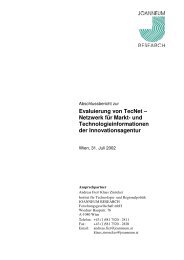Technology Rating - fteval
Technology Rating - fteval
Technology Rating - fteval
Sie wollen auch ein ePaper? Erhöhen Sie die Reichweite Ihrer Titel.
YUMPU macht aus Druck-PDFs automatisch weboptimierte ePaper, die Google liebt.
<strong>Technology</strong> rating –<br />
a venture capitalist’s perspective<br />
Reinhard Gert Jonke<br />
Introduction by Thomas Jud<br />
A profit driven investor faced with the option to invest<br />
in a promising company or project will draw his at-<br />
tention to the value of the venture represented by its<br />
capacity to generate future earnings. In order to de-<br />
termine the subject of interest he will employ various<br />
valuation tools provided by corporate finance theory<br />
which are more or less modifications of the widely<br />
known discounted cash flow method:<br />
Expected future cash flows are discounted back to<br />
find their present value which is in turn compared to<br />
the initial investment. If discounted cash flows exceed<br />
initial costs the investment project is valued to be<br />
profitable and different projects can be ranked by<br />
their degree of profitability.<br />
The main elements needed to apply this kind of<br />
analysis are a realistic projection of future cash flows<br />
and an appropriately determined discount rate. With<br />
these figures at hand an investor is able to value all<br />
the opportunities he is facing no matter if he is buying<br />
shares in a particular company or funding a single<br />
project. In order to calculate the figures at stake so-<br />
phisticated historical data on comparable cash flow<br />
streams, associated risks etc. is needed which can<br />
properly be extrapolated in the future. This kind of<br />
information is, however, hardly available if we turn to<br />
investments in technology-based projects or compa-<br />
nies.<br />
<strong>Technology</strong>-based projects tend to take a rather long<br />
time before they generate first earnings and break<br />
even eventually. Typically they run through several<br />
successive stages before any results can be com-<br />
mercialised. Even if new products or services have<br />
reached the market considerable time is required<br />
before profitable market positions can be established.<br />
Since investments are needed in early stages of<br />
projects potential investors are urged to make fund-<br />
ing decisions faced with negative cash flows. Apply-<br />
ing the DCF method based on this kind of data would<br />
clearly lead them to turn down respective investment<br />
opportunities. Such problems can be solved by sub-<br />
stituting in more comprehensive financial data gener-<br />
ated by comparable projects the company has al-<br />
ready carried out in the past.<br />
This may work for already established firms but not<br />
for young, newly founded ventures struggling to get<br />
their new product or service to the market and to set<br />
up a profitable market position for the first time. Such<br />
firms do not have a history or a track record which<br />
can be used for valuation purposes by a potential<br />
investor. The data necessary has to be drawn from<br />
external sources similar enough to the venture at<br />
stake in order to deliver appropriate results.<br />
Though the proposed procedure may be appropriate<br />
for firms producing incremental innovations, it runs<br />
into problems if radically or even fundamentally new<br />
technological ideas are to be developed. The chance<br />
to find comparable data shrinks because firms and<br />
their products get increasingly unique.<br />
Having considered the difficulties of valuing new<br />
technology-based firms we have singled out the main<br />
problems faced by venture capitalists – a particular<br />
type of equity capital investor. As profit driven agents<br />
they invest in promising technology-based high-<br />
growth firms in order to realise returns by selling their<br />
shares after several years when they have consid-<br />
erably increased in value. Their main business is to<br />
select appropriate investee companies by evaluating<br />
5


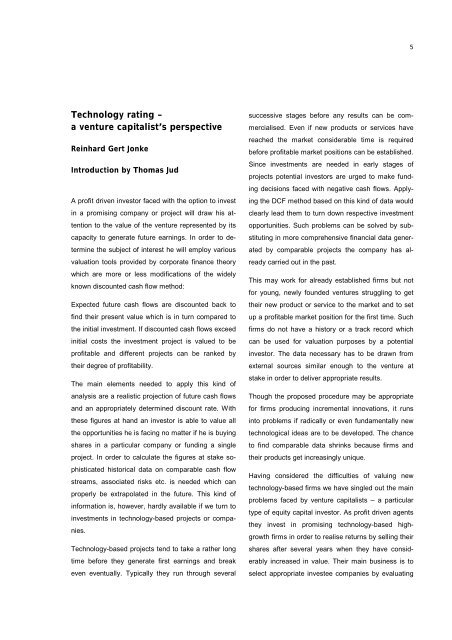


![roadMAP [PDF, 1.9 MB] - fteval](https://img.yumpu.com/21079876/1/184x260/roadmap-pdf-19-mb-fteval.jpg?quality=85)
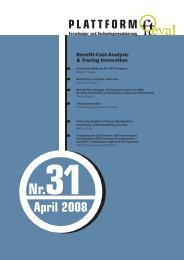


![GuggenbergeronBoku [PDF, 73.4 KB] - fteval](https://img.yumpu.com/21024081/1/184x260/guggenbergeronboku-pdf-734-kb-fteval.jpg?quality=85)

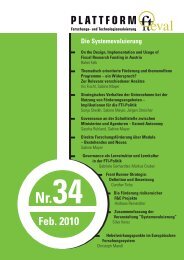
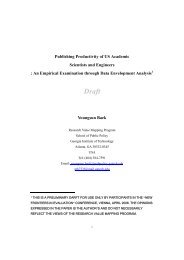

![ITF_Energietechnik [PDF, 39.6 KB] - fteval](https://img.yumpu.com/20959076/1/184x260/itf-energietechnik-pdf-396-kb-fteval.jpg?quality=85)
![Evaluation Standards [PDF, 120.8 KB] - fteval](https://img.yumpu.com/20931509/1/184x260/evaluation-standards-pdf-1208-kb-fteval.jpg?quality=85)
